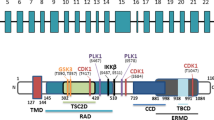Summary.
Uncontrolled cell cycle progression and cell growth are key properties of tumor cells. The tumor suppressor genes responsible for the autosomal dominantly inherited disease tuberous sclerosis (TSC) have been demonstrated to control both, cell cycle and cell size regulation. Hamartin, encoded by TSC1, and tuberin, encoded by TSC2, form a complex, of which tuberin is assumed to be the functional component. Loss of TSC genes function triggers hamartoma development in TSC patients. However, in vivo mostly tumor cell development is rapidly terminated via apoptosis. BCL-2, the founding member of the BCL-2 family of proteins, is well known for its anti-apoptotic properties. Here we show that pro-apoptotic actinomycin D cannot interfere with BCL-2’s cell survival functions. However, we found tuberin to negatively regulate BCL-2’s anti-apoptotic effects on low serum-induced apoptosis. These findings warrant further investigations to elucidate the molecular mechanism underlying tuberin’s negative effects on cell survival.
Similar content being viewed by others
References
JM Adams (2003) ArticleTitleWay of dying: multiple pathways to apoptosis Genes Dev 17 2481–2495 Occurrence Handle14561771 Occurrence Handle1:CAS:528:DC%2BD3sXotlWjtL8%3D Occurrence Handle10.1101/gad.1126903
C Borner (1996) ArticleTitleDiminished cell proliferation associated with the death-protective activity of Bcl-2 J Biol Chem 271 12695–12698 Occurrence Handle8663032 Occurrence Handle1:CAS:528:DyaK28XjtlGjt78%3D
NN Danial SJ Korsmeyer (2004) ArticleTitleCell death: critical control points Cell 116 205–219 Occurrence Handle14744432 Occurrence Handle1:CAS:528:DC%2BD2cXhtValsrY%3D Occurrence Handle10.1016/S0092-8674(04)00046-7
TF Franke CP Hornik L Segev GA Shostak C Sugimoto (2003) ArticleTitlePI3K/Akt and apoptosis: size matters Oncogene 22 8983–8998 Occurrence Handle14663477 Occurrence Handle1:CAS:528:DC%2BD3sXpsFOmsrg%3D Occurrence Handle10.1038/sj.onc.1207115
Freilinger A, Rosner M, Krupitza G, Nishino M, Lubec G, Korsmeyer SJ, Hengstschläger M (2006) Tuberin activates the pro-apoptotic molecule BAD. Oncogene (DOI: 10.1038/sj.onc.1209660)
H Harada JS Andersen M Mann N Terada SJ Korsmeyer (2001) ArticleTitlep70S6kinase signals cell survival as well as growth, inactivating the pro-apoptotic molecule BAD Proc Natl Acad Sci USA 98 9666–9670 Occurrence Handle11493700 Occurrence Handle1:CAS:528:DC%2BD3MXmtlCnu7o%3D Occurrence Handle10.1073/pnas.171301998
M Hengstschläger G Hölzl E Hengstschläger-Ottnad (1999) ArticleTitleDifferent regulation of c-Myc- and E2F-1-induced apoptosis during the ongoing cell cycle Oncogene 18 843–848 Occurrence Handle9989838 Occurrence Handle10.1038/sj.onc.1202342
KW Henry X Yuan NJ Koszewski H Onda DJ Kwiatkowski DJ Noonan (1998) ArticleTitleTuberous sclerosis gene 2 product modulates transcription mediated by steroid hormone receptor family members J Biol Chem 273 20535–20539 Occurrence Handle9685410 Occurrence Handle1:CAS:528:DyaK1cXlsVWgu74%3D Occurrence Handle10.1074/jbc.273.32.20535
K Inoki T Zhu K-L Guan (2003) ArticleTitleTSC2 mediates cellular energy response to control cell growth and survival Cell 115 577–590 Occurrence Handle14651849 Occurrence Handle1:CAS:528:DC%2BD3sXps1OhtL0%3D Occurrence Handle10.1016/S0092-8674(03)00929-2
TM Kolb L Duan MA Davis (2005) ArticleTitleTsc2 expression increases the susceptibility of renal tumor cells to apoptosis Toxicol Sci 88 331–339 Occurrence Handle16150885 Occurrence Handle1:CAS:528:DC%2BD2MXht1Wis73J Occurrence Handle10.1093/toxsci/kfi310
DJ Kwiatkowski (2003) ArticleTitleTuberous sclerosis: from tubers to mTOR Ann Hum Genet 67 87–96 Occurrence Handle12556239 Occurrence Handle1:CAS:528:DC%2BD3sXnslKms70%3D Occurrence Handle10.1046/j.1469-1809.2003.00012.x
Y Li MN Corradetti K Inoki K-L Guan (2003) ArticleTitleTSC2: filling the GAP in the mTOR signalling pathway Trends Biochem Sci 29 32–38 Occurrence Handle10.1016/j.tibs.2003.11.007
A Miloloza M Rosner M Nellist D Halley G Bernaschek M Hengstschläger (2000) ArticleTitleThe TSC1 gene product, hamartin, negatively regulates cell proliferation Hum Mol Genet 9 1721–1727 Occurrence Handle10915759 Occurrence Handle1:CAS:528:DC%2BD3cXlsFOqtbc%3D Occurrence Handle10.1093/hmg/9.12.1721
D Pan J Dong Y Zhang X Gao (2004) ArticleTitleTuberous sclerosis complex: from Drosophila to human disease Trends Cell Biol 14 78–85 Occurrence Handle15102439 Occurrence Handle1:CAS:528:DC%2BD2cXhtVOrtL8%3D Occurrence Handle10.1016/j.tcb.2003.12.006
KBS Pasumarthi H Nakajima HO Nakajima S Jing LJ Field (2000) ArticleTitleEnhanced cardiomyocyte DNA synthesis during myocardial hypertrophy in mice expressing a modified TSC2 transgene Circ Res 86 1069–1077 Occurrence Handle10827137 Occurrence Handle1:CAS:528:DC%2BD3cXjvFenurg%3D
AM Ranger J Zha H Harada SR Datta NN Danial AP Gilmore JL Kutok MM LeBeau ME Greenberg SJ Korsmeyer (2003) ArticleTitleBad-deficient mice develop diffuse large B cell lymphoma Proc Natl Acad Sci USA 100 9324–9329 Occurrence Handle12876200 Occurrence Handle10.1073/pnas.1533446100
M Rosner M Hengstschläger (2004) ArticleTitleTuberin binds p27 and negatively regulates its interaction with the SCF component Skp2 J Biol Chem 279 48707–48715 Occurrence Handle15355997 Occurrence Handle1:CAS:528:DC%2BD2cXpslGqtLc%3D Occurrence Handle10.1074/jbc.M405528200
OJ Shah Z Wang T Hunter (2004) ArticleTitleInappropriate activation of the TSC/Rheb/mTOR/S6K cassette induces IRS1/2 depletion, insulin resistance, and cell survival deficiencies Curr Biol 14 1650–1656 Occurrence Handle15380067 Occurrence Handle1:CAS:528:DC%2BD2cXnvFansb8%3D Occurrence Handle10.1016/j.cub.2004.08.026
CJ Sherr (2000) ArticleTitleThe Pezcoller lecture: cancer cell cycles revisited Cancer Res 60 3689–3695 Occurrence Handle10919634 Occurrence Handle1:CAS:528:DC%2BD3cXlt1Gksbs%3D
T Soucek O Pusch R Wienecke JE DeClue M Hengstschläger (1997) ArticleTitleRole of the tuberous sclerosis gene 2 product in cell cycle control J Biol Chem 272 29301–29308 Occurrence Handle9361010 Occurrence Handle1:CAS:528:DyaK2sXnsVOgtLs%3D Occurrence Handle10.1074/jbc.272.46.29301
T Soucek RS Yeung M Hengstschläger (1998) ArticleTitleInactivation of the cyclin-dependent kinase inhibitor p27 upon loss of the tuberous sclerosis complex gene 2 Proc Natl Acad Sci USA 95 15653–15658 Occurrence Handle9861025 Occurrence Handle1:CAS:528:DyaK1MXhvFeitw%3D%3D Occurrence Handle10.1073/pnas.95.26.15653
InstitutionalAuthorNameThe European Chromosome 16 Tuberous Sclerosis Consortium (1993) ArticleTitleIdentification and characterization of the tuberous sclerosis gene on chromosome 16 Cell 75 1305–1315
InstitutionalAuthorNameThe TSC1 Consortium (1997) ArticleTitleIdentification of the tuberous sclerosis gene TSC1 on chromosome 9q34 Science 277 805–808 Occurrence Handle10.1126/science.277.5327.805
B Vogelstein KW Kinzler (2004) ArticleTitleCancer genes and the pathway they control Nature Med 10 789–799 Occurrence Handle15286780 Occurrence Handle1:CAS:528:DC%2BD2cXmtFWrt7o%3D Occurrence Handle10.1038/nm1087
G-H Xiao F Shoarinejad F Jin EA Golemis RS Yeung (1997) ArticleTitleThe tuberous sclerosis 2 gene product, tuberin, functions as a Rab5 GTPase activating protein (GAP) in modulating endocytosis J Biol Chem 272 6097–6100 Occurrence Handle9045618 Occurrence Handle1:CAS:528:DyaK2sXhvVOntrw%3D Occurrence Handle10.1074/jbc.272.10.6097
J Zha H Harada E Yang J Jockel SJ Korsmeyer (1996) ArticleTitleSerine phosphorylation of death agonist BAD in response to survival factor results in binding to 14-3-3 not BCL-X(L) Cell 87 619–628 Occurrence Handle8929531 Occurrence Handle1:CAS:528:DyaK28XntVarsLY%3D Occurrence Handle10.1016/S0092-8674(00)81382-3
Author information
Authors and Affiliations
Rights and permissions
About this article
Cite this article
Freilinger, A., Rosner, M. & Hengstschläger, M. Tuberin negatively affects BCL-2’s cell survival function. Amino Acids 30, 391–396 (2006). https://doi.org/10.1007/s00726-006-0359-1
Received:
Accepted:
Published:
Issue Date:
DOI: https://doi.org/10.1007/s00726-006-0359-1




